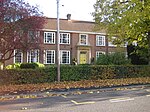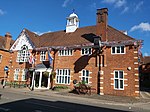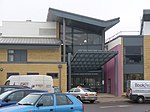St Joan of Arc's Church, Farnham
1930 establishments in England20th-century Roman Catholic church buildings in the United KingdomBuildings and structures in FarnhamEngvarB from September 2019Farnham ... and 5 more
Grade II listed Roman Catholic churches in EnglandGrade II listed churches in SurreyRoman Catholic churches completed in 1930Roman Catholic churches in SurreyRomanesque Revival church buildings in England

St Joan of Arc Church is a Roman Catholic Parish church in Farnham, Surrey. It was founded in 1890 and built in its present location in 1929. It was decided that the Farnham church should be dedicated to St Joan of Arc because Farnham Castle was a residence of Cardinal Henry Beaufort who was present at her trial. It is a Romanesque Revival church and a Grade II listed building. It is situated between Tilford Road and Waverley Lane, south of Farnham Railway Station.
Excerpt from the Wikipedia article St Joan of Arc's Church, Farnham (License: CC BY-SA 3.0, Authors, Images).St Joan of Arc's Church, Farnham
Waverley Lane, Waverley
Geographical coordinates (GPS) Address Nearby Places Show on map
Geographical coordinates (GPS)
| Latitude | Longitude |
|---|---|
| N 51.2111 ° | E -0.7892 ° |
Address
St Joan of Arc
Waverley Lane
GU9 8BJ Waverley
England, United Kingdom
Open on Google Maps








